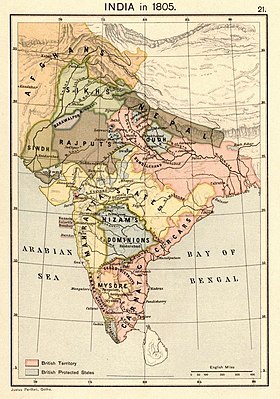

Greater Nepal is an irrendentist concept in Nepal,[1] which claims current Indian and Bangladeshi territories beyond Nepal's present-day boundaries.[2] These claims typically include the areas controlled by Nepal between 1791 and 1816, a period that ended with the Anglo-Nepalese War and the signing of Sugali Treaty.[3] In addition, extensive territories in the present-day Indian states of Uttar Pradesh, Bihar, West Bengal and some parts of Bangladesh are also included in the claims of the activist organisation Greater Nepal Nationalist Front, which demands the "return" of these territories to Nepal.[2][4] A map similar to theirs was displayed by the mayor of Kathmandu in his office in June 2023, in reaction to an alleged "Akhand Bharat" map in the Indian Parliament building.[5][6]
Nepal extended from the Sutlej to the Teesta River during the unification initiate by Prithvi Narayan Shah in 1743. Gorkha rule over this expanded territory lasted only up to 1815. The Gorkhali presence in Garhwal was for 12 years, Kumaon for 24 years, and Sikkim for 33 years. The expansion of Gorkha ended with the 1814-1815 war with the East India Company. The ensuing Treaty of Sugauli, between the Gorkhali king and the East India Company, reset Nepal's boundaries in the east and west to the present boundaries. According to the Greater Nepal advocates, this caused a loss of 176,000 km2 of territory to Nepal.[7][better source needed]
Greater Nepal Nationalist Front (GNNF, formerly "Unified Nepal National Front")[4][8] is a Nepalese NGO headed by Phanindra Nepal, which champions the cause of Greater Nepal. The organisation disowns the 1810 Sugauli Treaty and the 1950 Treaty of Peace and Friendship with India. It demands the return of the land that belonged to Nepal before the signing of the Sugauli Treaty. This involves land up to the Sutlej River in the west, the Teesta River in the east ("Shimla to Darjeeling" in the organisation's parlance) and extending up to Varanasi in the south.[4]
Scholars Mishra and Haque state that the organisation is rhetorically very powerful. The map of Greater Nepal produced by the organisation provides power to the movement by building "meanings and nostalgic longings". The movement has a web page in the Nepali language, a Facebook page and blog sites.[4]
An even more grandiose movement is said to talk about "Unified Gorkha-States of India Sub-Continent", which restructures the Indian subcontinent into five autonomous states, the largest of which is the so-called "Arya Autonomous State".[4]
A Maoist movement has published a 260-page Nepali book titled "Nepal: Teesta Dekhi Satlej Samma" ("Nepal: From Teesta to the Sutlej") which, while repeating similar demands to the GNNF, also provides copious references to alleged historical facts. Among others, it claims that the Indian prime minister Jawaharlal Nehru supported the idea of "Greater Nepal".[3] Their map includes the Indian towns of Varanasi, Ballia, Bahraich, Pilibhit and Jaunpur within Greater Nepal.[9] The Maoist leader Prachanda dismissed the claims in an interview with the Times of India as a "media-created stunt". But according to the Times of India the book was readily available in and around the Maoist camps along the Indo-Nepal border in 2005.[3] The Maoist-affiliated Indian Nepalis advocacy group Akhil Bharat Nepali Ekta Samaj is also supportive of the greater Nepali ideal according to some sources.[10]
Scholars and retired officials such as Buddhi Narayan Shrestha (former Director of the Survey Department) and Dwarika Nath Dhungel (former secretary of Water Resources) have published scholarly articles with maps labelled "Greater Nepal".[11][12][13] Shrestha has also spoken in Greater Nepal gatherings[14][15] and made media comments in its favour, declaring "The land we lost to the East India Company should not belong to India. It is ours."[16]
Shreshta narrates that, before the Sugauli Treaty, Nepal extended up to the confluence of Gandak and Ganges Rivers in the south, and to Shigatse and Tashilhunpo in the north. "It was called the 'Greater Nepal'", he states, without mentioning who called it so.[17] British India apparently "did not like" Greater Nepal as a unified country and therefore dismembered it.[18] He alleges that the British wanted to expand trade into Tibet but, since Nepal stood in the way, they needed to cut it down.[19]
No king of Nepal has ever discussed or approved of the concept of "Greater Nepal".[citation needed] However, upon forming a coalition government after the 2008 Nepalese Constituent Assembly election, the leader of the Communist Party of Nepal (Maoist) and then-prime minister Pushpa Kamal Dahal (popularly known as "Prachanda") stated that the 1950 Indo-Nepal Treaty of Peace and Friendship would be "scrapped".[20] However, the matter was pursued no further. He resigned nine months later for other reasons. Late Nepali Prime Minister Girija Prasad Koirala called the idea of Greater Nepal "a product of unstable minds". According to Kanak Mani Dixit, as of 1993, the mainstream Left of Nepal appears ambivalent: "They like the concept but are unwilling to do anything about it."[21]
In 2023 when the Mauryan Empire mural in India's new Parliament building appeared in the newspapers, some politicians of the ruling Bharatiya Janata Party started branding it an Akhand Bharat map. The fact that included some Nepalese towns such as Lumbini and Kapilavastu produced consternation in Nepal. The mayor of Kathmandu, Balen Shah placed a map of Greater Nepal in his office as a protest.[22][23]